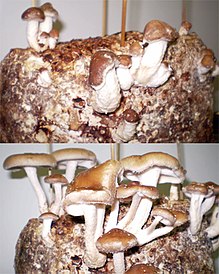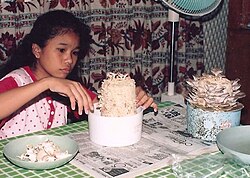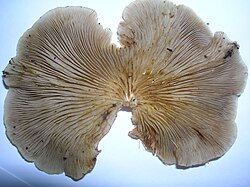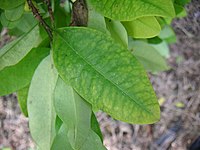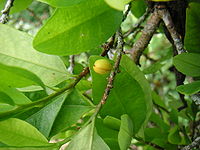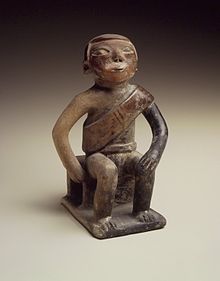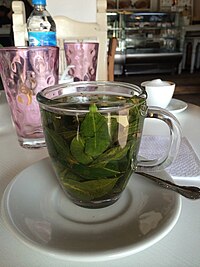From Wikipedia, the free encyclopedia
Coca is any of the four cultivated plants in the
family Erythroxylaceae, native to western South America.
The plant is grown as a
cash crop in
Argentine Northwest,
Bolivia,
Colombia,
Ecuador, and
Peru, even in areas where its cultivation is unlawful.
There are some reports that the plant is being cultivated in the south of
Mexico as a
cash crop and an alternative to
smuggling its recreational product
cocaine.
It also plays a role in many traditional
Andean cultures as well as the
Sierra Nevada de Santa Marta.
Coca is known throughout the world for its psychoactive
alkaloid,
cocaine. The alkaloid content of coca leaves is relatively low, between 0.25% and 0.77%. The native people use it for a stimulant, like coffee, or an energy source or both.
Coca-Cola used coca leaf extract in its products from 1885 and until about 1903. Extraction of cocaine from coca requires several solvents and a chemical process known as an
acid-base extraction, which can fairly easily extract the alkaloids from the plant.
Description
The coca plant resembles a
blackthorn
bush, and grows to a height of 2 to 3 metres (7 to 10 feet). The
branches are straight, and the leaves are thin, opaque, oval, and taper
at the extremities. A marked characteristic of the leaf is an areolated
portion bounded by two longitudinal curved lines, one line on each side
of the midrib, and more conspicuous on the under face of the leaf.
The flowers are small, and disposed in clusters on short stalks; the corolla is composed of five yellowish-white
petals, the
anthers are heart-shaped, and the
pistil consists of three carpels united to form a three-chambered ovary. The flowers mature into red
berries.
Species and evolution
There are two species of cultivated coca, each with two varieties:
- Erythroxylum coca
- Erythroxylum coca var. coca (Bolivian or Huánuco Coca) – well adapted to the eastern Andes of Peru and Bolivia, an area of humid, tropical, montane forest.
- Erythroxylum coca var. ipadu (Amazonian Coca) – cultivated in the lowland Amazon Basin in Peru and Colombia.
- Erythroxylum novogranatense
- Erythroxylum novogranatense var. novogranatense
(Colombian Coca) – a highland variety that is utilized in lowland areas.
It is cultivated in drier regions found in Colombia. However, E. novogranatense is very adaptable to varying ecological conditions. The leaves have parallel lines on either side of the central vein.
- Erythroxylum novogranatense var. truxillense (Trujillo Coca) – grown primarily in Peru and Colombia. the leaves of E. novogranatense var. truxillense do not have parallel lines on either side of the central vein like all other varieties.
All four of the cultivated cocas were domesticated in pre-Columbian
times and are more closely related to each other than to any other
species.
There are two main theories relating to the evolution of the cultivated cocas. The first (put forth by
Plowman and Bohm) suggests that
Erythroxylum coca var.
coca is ancestral, while
Erythroxylum novogranatense var.
truxillense is derived from it to be drought tolerant, and
Erythroxylum novogranatense var.
novogranatense derived from
Erythroxylum novogranatense var.
truxillense.
Recent research based on genetic evidence (Johnson et al. in 2005, Emche et al. in 2011, and Islam 2011) does not support this linear evolution and instead suggests a second domestication event as the origin of the
Erythroxylum novogranatense varieties. There may be a common, but undiscovered ancestor.
Wild populations of
Erythroxylum coca var.
coca are found in the eastern
Andes; the other 3
taxa are only known as cultivated plants.
Herbicide resistant varieties
Also known as
supercoca or
la millionaria,
Boliviana negra is a relatively new form of coca that is resistant to a
herbicide called
glyphosate. Glyphosate is a key ingredient in the multibillion-dollar aerial
coca eradication campaign undertaken by the government of Colombia with U.S. financial and military backing known as
Plan Colombia.
The herbicide resistance of this strain has at least two possible explanations: that a "
peer-to-peer" network of coca farmers used
selective breeding to enhance this trait through tireless effort, or the plant was
genetically modified in a laboratory. In 1996, a
patented glyphosate-resistant
soybean was marketed by
Monsanto Company, suggesting that it would be possible to genetically modify coca in an analogous manner. Spraying
Boliviana negra with glyphosate would serve to strengthen its growth by eliminating the non-resistant
weeds surrounding it. Joshua Davis, in the
Wired article cited below, found no evidence of CP4 EPSPS, a protein produced by the glyphosate-resistant soybean, suggesting
Bolivana negra was either created in a lab by a different technique or bred in the field.
Cultivation
Coca is traditionally cultivated in the lower altitudes of the eastern slopes of the
Andes (the
Yungas),
or the highlands depending on the species grown. Coca production begins
in the valleys and upper jungle regions of the Andean region, where the
countries of Colombia, Peru and Bolivia are host to more than 98 per
cent of the global land area planted with coca. Coca plantations have also recently been discovered in
Mexico, which could have major implications for the illegal cultivation of the plant.
The seeds are sown from December to January in small plots (
almacigas)
sheltered from the sun, and the young plants when at 40 to 60
centimetres (16 to 24 inches) in height are placed in final planting
holes (
aspi), or if the ground is level, in furrows (
uachos) in carefully
weeded
soil. The plants thrive best in hot, damp and humid locations, such as
the clearings of forests; but the leaves most preferred are obtained in
drier areas, on the hillsides. The leaves are gathered from plants
varying in age from one and a half to upwards of forty years, but only
the new fresh growth is harvested. They are considered ready for
plucking when they break on being bent. The first and most abundant
harvest is in March after the rainy season, the second is at the end of
June, and the third in October or November. The green leaves (
matu) are spread in thin layers on coarse
woollen
cloths and dried in the sun; they are then packed in sacks, which must
be kept dry in order to preserve the quality of the leaves.
Morphology of the coca plant
Pharmacological aspects
The
pharmacologically active ingredient of coca is the cocaine alkaloid, which is found in the amount of about 0.3 to 1.5%, averaging 0.8%, in fresh leaves. Besides cocaine, the coca leaf contains a number of other alkaloids, including
methylecgonine cinnamate,
benzoylecgonine,
truxilline,
hydroxytropacocaine,
tropacocaine,
ecgonine,
cuscohygrine,
dihydrocuscohygrine,
nicotine, and
hygrine. When chewed, coca acts as a mild stimulant and suppresses hunger, thirst, pain, and fatigue.
Absorption of coca from the leaf is less rapid than nasal application
of purified forms of the alkaloid (almost all of the coca alkaloid is
absorbed within 20 minutes of nasal application, while it takes 2–12 hours after ingestion of the raw leaf for alkaline concentrations to peak.). When the raw leaf is consumed in tea, between 59 and 90% of the coca alkaloid is absorbed.
The coca leaf, when consumed in its natural form, does not induce
a physiological or psychological dependence, nor does abstinence after
long-term use produce symptoms typical to substance addiction.
Due to its alkaloid content and non-addictive properties, coca has been
suggested as a method to help recovering cocaine addicts to wean off
the drug.
History
Workers in Java prepared coca leaves. This product was mainly traded in Amsterdam, and was further processed into cocaine. (Dutch East Indies, before 1940.)
Traces of coca leaves found in northern Peru dates the communal chewing of coca with lime 8000 years back. Other evidence of coca traces have been found in
mummies dating 3000 years back in northern Chile.
Beginning with the Valdivian culture, circa 3000 BC, there is an
unbroken record of coca leaf consumption by succeeding cultural groups
on the coast of Ecuador until European arrival as shown in their ceramic
sculpture and abundant caleros or lime pots. Lime containers found in
the north coast of Peru date around 2000 BC as evidenced by the findings
at
Huaca Prieta
and the Jetetepeque river valley. Extensive archaeological evidence for
the chewing of coca leaves dates back at least to the 6th century AD
Moche period, and the subsequent
Inca
period, based on mummies found with a supply of coca leaves, pottery
depicting the characteristic cheek bulge of a coca chewer, spatulas for
extracting alkali and figured bags for coca leaves and lime made from
precious metals, and gold representations of coca in special gardens of
the Inca in
Cuzco.
Coca chewing may originally have been limited to the eastern
Andes before its introduction to the Inca. As the plant was viewed as
having a divine origin, its cultivation became subject to a
state monopoly
and its use restricted to nobles and a few favored classes (court
orators, couriers, favored public workers, and the army) by the rule of
the
Topa Inca (1471–1493). As the Incan empire declined, the leaf became more widely available. After some deliberation,
Philip II of Spain
issued a decree recognizing the drug as essential to the well-being of
the Andean Indians but urging missionaries to end its religious use. The
Spanish are believed to have effectively encouraged use of coca by an
increasing majority of the population to increase their labor output and
tolerance for starvation, but it is not clear that this was planned
deliberately.
Coca was first introduced to Europe in the 16th century, but did
not become popular until the mid-19th century, with the publication of
an influential paper by Dr.
Paolo Mantegazza praising its stimulating effects on cognition. This led to invention of
coca wine and the first production of pure cocaine. Coca wine (of which
Vin Mariani
was the best-known brand) and other coca-containing preparations were
widely sold as patent medicines and tonics, with claims of a wide
variety of health benefits. The original version of
Coca-Cola
was among these. These products became illegal in most countries
outside of South America in the early 20th century, after the addictive
nature of cocaine was widely recognized. In 1859,
Albert Niemann of the
University of Göttingen became the first person to isolate the chief alkaloid of coca, which he named "cocaine".
In the early 20th century, the Dutch colony of
Java became a leading exporter of
coca leaf.
By 1912 shipments to Amsterdam, where the leaves were processed into
cocaine, reached 1000 tons, overtaking the Peruvian export market. Apart
from the years of the First World War, Java remained a greater exporter
of coca than Peru until the end of the 1920s. Other colonial powers also tried to grow coca (including the British in India), but with the exception of the Japanese in
Formosa, these were relatively unsuccessful.
In recent times (2006), the governments of several South American
countries, such as Peru, Bolivia and Venezuela, have defended and
championed the traditional use of coca, as well as the modern uses of
the leaf and its extracts in household products such as teas and
toothpaste. The coca plant was also the inspiration for Bolivia's
Coca Museum.
Traditional uses
Man holding coca leaf in Bolivia
Medicine
Traditional
medical uses of coca are foremost as a stimulant to overcome fatigue,
hunger, and thirst. It is considered particularly effective against
altitude sickness. It also is used as an
anesthetic and analgesic to alleviate the pain of headache,
rheumatism, wounds and sores, etc. Before stronger anaesthetics were available, it also was used for broken bones, childbirth, and during
trepanning operations on the skull. The high calcium content in coca explains why people used it for bone fractures. Because coca constricts blood vessels, it also serves to oppose bleeding, and coca seeds were used for
nosebleeds. Indigenous use of coca has also been reported as a treatment for
malaria,
ulcers,
asthma, to improve
digestion, to guard against bowel laxity, as an
aphrodisiac, and credited with improving
longevity. Modern studies have supported a number of these medical applications.
Nutrition
Raw
coca leaves, chewed or consumed as tea or mate de coca, are rich in
nutritional properties. Specifically, the coca plant contains essential
minerals (calcium, potassium, phosphorus), vitamins (
B1,
B2,
C, and
E) and nutrients such as protein and fiber.
Religion
Coca
has also been a vital part of the religious cosmology of the Andean
peoples of Peru, Bolivia, Ecuador, Colombia, northern Argentina, and
Chile from the
pre-Inca period through to the present. Coca leaves play a crucial part in offerings to the
apus (mountains),
Inti (the sun), or
Pachamama (the earth). Coca leaves are also often read in a form of
divination analogous to
reading tea leaves in other cultures. As one example of the many traditional beliefs about coca, it is believed by the miners of
Cerro de Pasco to soften the veins of
ore, if masticated (chewed) and thrown upon them (see
Cocomama in
Inca mythology).
In addition, coca use in shamanic rituals is well documented wherever
local native populations have cultivated the plant. For example, the
Tayronas of Colombia's Sierra Nevada de Santa Marta would chew the plant
before engaging in extended meditation and prayer.
Traditional preparation
Traditionally, coca leaves are prepared either to chew or as a tea (
mate de coca).
Chew
In Bolivia bags of coca leaves are sold in local markets and by street vendors. The activity of chewing coca is called
mambear,
chacchar or
acullicar, borrowed from
Quechua,
coquear (northern Argentina), or in Bolivia,
picchar, derived from the
Aymara language. The Spanish
masticar
is also frequently used, along with the slang term "bolear," derived
from the word "bola" or ball of coca pouched in the cheek while chewing.
Typical coca consumption varies between 20 and 60 grams per day, and contemporary methods are believed to be unchanged from ancient times. Coca is kept in a woven pouch (
chuspa or
huallqui). A few leaves are chosen to form a quid
(acullico)
held between the mouth and gums. Doing so may cause a tingling and
numbing sensation in their mouths. (The formerly ubiquitous dental
anaesthetic
novocaine / procaine has a similar effect.)
Chewing coca leaves is most common in indigenous communities across the central Andean region,
particularly in places like the highlands of Argentina, Colombia,
Bolivia, and Peru, where the cultivation and consumption of coca is a
part of the national culture, similar to
chicha.
It also serves as a powerful symbol of indigenous cultural and
religious identity, amongst a diversity of indigenous nations throughout
South America.
Tobacco leaves were also traditionally chewed in the same way in North America, though modern
chewing tobacco is typically heavily processed.
llipta is used to improve extraction when chewing coca (Museo de la Coca, Cusco, Peru)
One option for chewing coca is with a tiny quantity of
ilucta (a preparation of the ashes of the
quinoa plant) added to the coca leaves; it softens their
astringent flavor and activates the
alkaloids. Other names for this basifying substance are
llipta in Peru and the Spanish word
lejía,
bleach
in English. The consumer carefully uses a wooden stick (formerly often a
spatula of precious metal) to transfer an alkaline component into the
quid without touching his flesh with the corrosive substance. The alkali
component, usually kept in a gourd (
ishcupuro or
poporo), can be made by burning
limestone to form unslaked
quicklime, burning quinoa stalks, or the bark from certain trees, and may be called
ilipta,
tocra or
mambe depending on its composition. Many of these materials are salty in flavor, but there are variations. The most common base in the
La Paz area of Bolivia is a product known as
lejía dulce (
sweet lye), which is made from quinoa ashes mixed with
aniseed and cane sugar, forming a soft black putty with a sweet and pleasing flavor. In some places,
baking soda is used under the name
bico.
In the
Sierra Nevada de Santa Marta, on the Caribbean Coast of Colombia, coca is consumed by the
Kogi,
Arhuaco, and
Wiwa by using a special device called
poporo.
It represents the womb and the stick is a phallic symbol. The movements
of the stick in the poporo symbolize the sexual act. For a man the
poporo is a good companion that means "food", "woman", "memory", and
"meditation". The poporo is the mark of manhood. When a boy is ready to
be married, his mother initiates him in the use of the coca. This act of
initiation is carefully supervised by the Mamo, a traditional
priest-teacher-leader.
Fresh samples of the dried leaves, uncurled, are a deep green
colour on the upper surface, and a grey-green on the lower surface, and
have a strong
tea-like aroma. When chewed, they produce a pleasurable numbness in the mouth, and have a pleasant,
pungent taste. They are traditionally chewed with
lime or some other reagent such as
bicarbonate of soda to increase the release of the active ingredients from the leaf. Older species have a
camphoraceous smell and a brownish color, and lack the pungent taste.
Tea
Although coca leaf chewing is common only among the indigenous populations, the consumption of coca tea (
Mate de coca) is common among all sectors of society in the Andean countries, especially due to their high elevations from sea level, and is widely held to be beneficial to health, mood, and energy.
Coca leaf is sold packaged into teabags in most grocery stores in the
region, and establishments that cater to tourists generally feature coca
tea.
Commercial and industrial uses
In
the Andes commercially manufactured coca teas, granola bars, cookies,
hard candies, etc. are available in most stores and supermarkets,
including upscale suburban supermarkets.
Coca is used industrially in the cosmetics and food industries. A
decocainized extract of coca leaf is one of the flavoring ingredients
in
Coca-Cola.
Before the criminalization of cocaine, however, the extract was not
decocainized. Therefore, Coca-Cola's original formula did include
cocaine.
Coca tea
is produced industrially from coca leaves in South America by a number
of companies, including Enaco S.A. (National Company of the Coca) a
government enterprise in Peru. Coca leaves are also found in a brand of herbal
liqueur called "Agwa de Bolivia" (grown in Bolivia and de-cocainized in Amsterdam), and a natural flavouring ingredient in
Red Bull Cola, that was launched in March 2008.
New markets
Beginning in the early 21st century, there has been a movement in Bolivia, Peru,
and Venezuela to promote and expand legal markets for the crop. The
presidents of these three countries have personally identified with this
movement. In particular,
Evo Morales of Bolivia (elected in December 2005) was a coca grower's union leader. Morales asserts that "
la coca no es cocaína"—the coca leaf is not cocaine. During his speech to the
General Assembly of the United Nations on September 19, 2006, he held a coca leaf in his hand to demonstrate its innocuity.
Alan García,
president of Peru, has recommended its use in salads and other edible
preparations. A Peruvian-based company has announced plans to market a
modern version of
Vin Mariani, which will be available in both natural and de-cocainized varieties.
In Venezuela, former president
Hugo Chávez
said in a speech on January 2008 that he chews coca every day, and that
his "hook up" is Bolivian president Evo Morales. Chávez reportedly said
"I chew coca every day in the morning... and look how I am" before
showing his
biceps to his audience, the
Venezuelan National Assembly.
On the other hand, the Colombian government has recently moved in the opposite direction. For years,
Bogotá
has allowed indigenous coca farmers to sell coca products, promoting
the enterprise as one of the few successful commercial opportunities
available to recognized tribes like the
Nasa, who have grown it for years and regard it as sacred. In December 2005, the Paeces – a Tierradentro (
Cauca) indigenous community – started to produce a carbonated soft drink called "
Coca Sek".
The production method belongs to the resguardos of Calderas (Inzá) and
takes about 150 kg (331 lb) of coca per 3,000 produced bottles. The
drink was never sold widely in Colombia and efforts to do so ended in
May 2007 when it was abruptly banned by the Colombian government.
Literary references
Probably the earliest reference to coca in English literature is
Abraham Cowley's poem "A Legend of Coca"
in his 1662 collection of poems "Six Books of Plants". In the series of
Aubrey-Maturin novels by Patrick O'Brien, set during the Napoleonic
wars, Dr. Stephen Maturin, a naval physician, naturalist, and British
intelligence agent discovers the use of coca leaves on a mission to
Peru, and makes regular use of them in several of the later novels in
the series.
International prohibition of coca leaf
Coca leaf is the raw material for the manufacture of the
drug cocaine, a powerful stimulant and
anaesthetic
extracted chemically from large quantities of coca leaves. Today, since
it has mostly been replaced as a medical anaesthetic by synthetic
analogues such as
procaine, cocaine is best known as an illegal
recreational drug.
The cultivation, sale, and possession of unprocessed coca leaf (but not
of any processed form of cocaine) is generally legal in the countries –
such as Bolivia, Peru, Chile, and
Argentine Northwest
– where traditional use is established, although cultivation is often
restricted in an attempt to control the production of cocaine.
In the case of Argentina, it is legal only in some northwest provinces
where the practice is so common that the state has accepted it.
The prohibition of the use of the coca leaf except for medical or
scientific purposes was established by the United Nations in the 1961
Single Convention on Narcotic Drugs. The coca leaf is listed on
Schedule I
of the 1961 Single Convention together with cocaine and heroin. The
Convention determined that "The Parties shall so far as possible enforce
the uprooting of all coca bushes which grow wild. They shall destroy
the coca bushes if illegally cultivated" (Article 26), and that, "Coca
leaf chewing must be abolished within twenty-five years from the coming
into force of this Convention" (Article 49, 2.e).
The historic rationale for international prohibition of coca leaf
in the 1961 Single Convention comes from "The Commission of Enquiry on
the Coca Leaf study" published in 1950. It was requested of the United
Nations by the permanent representative of Peru, and was prepared by a
commission that visited Bolivia and Peru briefly in 1949 to "investigate
the effects of chewing the coca leaf and the possibilities of limiting
its production and controlling its distribution." It concluded that the
effects of chewing coca leaves were negative, even though chewing coca
was defined as a habit, not an addiction.
The report was sharply criticised for its arbitrariness, lack of precision, and racist connotations.
The team members' professional qualifications and parallel interests
were also criticised, as were the methodology used and the incomplete
selection and use of existing scientific literature on the coca leaf.
Questions have been raised as to whether a similar study today would
pass the scrutiny and critical review to which scientific studies are
routinely subjected.
Despite the legal restriction among countries party to the
international treaty, coca chewing and drinking of coca tea is carried
out daily by millions of people in the Andes as well as considered
sacred within indigenous cultures. Coca consumers claim that most of the
information provided about the traditional use of the coca leaf and its
modern adaptations are erroneous.
This has made it impossible to shed light on the plant's positive
aspects and its potential benefits for the physical, mental, and social
health of the people who consume and cultivate it.
In an attempt to obtain international acceptance for the legal
recognition of traditional use of coca in their respective countries,
Peru and Bolivia successfully led an amendment, paragraph 2 of Article
14 into the 1988
United Nations Convention Against Illicit Traffic in Narcotic Drugs and Psychotropic Substances,
stipulating that measures to eradicate illicit cultivation and to
eliminate illicit demand "should take due account of traditional licit
use, where there is historic evidence of such use."
Bolivia also made a formal reservation to the 1988 Convention, which
required countries to adopt measures to establish the use, consumption,
possession, purchase or cultivation of the coca leaf for personal
consumption as a criminal offence. Bolivia stated that "the coca leaf is
not, in and of itself, a narcotic drug or psychotropic substance" and
stressed that its "legal system recognizes the ancestral nature of the
licit use of the coca leaf, which, for much of Bolivia's population,
dates back over centuries."
However, the
International Narcotics Control Board (INCB) – the independent and
quasi-judicial
control organ for the implementation of the United Nations drug
conventions – denied the validity of article 14 in the 1988 Convention
over the requirements of the 1961 Convention, or any reservation made by
parties, since it does not "absolve a party of its rights and
obligations under the other international drug control treaties."
The INCB stated in its 1994 Annual Report that "mate de coca,
which is considered harmless and legal in several countries in South
America, is an illegal activity under the provisions of both the 1961
Convention and the 1988 Convention, though that was not the intention of
the plenipotentiary conferences that adopted those conventions."
It implicitly also dismissed the original report of the Commission of
Enquiry on the Coca Leaf by recognizing that "there is a need to
undertake a scientific review to assess the coca-chewing habit and the
drinking of coca tea."
Nevertheless, the INCB on other occasions did not show signs of
an increased sensitivity towards the Bolivian claim on the rights of
their indigenous population, and the general public, to consume the coca
leaf in a traditional manner by chewing the leaf, and drinking coca
tea, as "not in line with the provisions of the 1961 Convention."
The Board considered Bolivia, Peru and a few other countries that allow
such practises to be in breach with their treaty obligations, and
insisted that "each party to the Convention should establish as a
criminal offence, when committed intentionally, the possession and
purchase of coca leaf for personal consumption."
In reaction to the 2007 Annual Report of the INCB, the Bolivian
government announced that it would formally issue a request to the
United Nations to unschedule the coca leaf of List 1 of the 1961 UN
Single Convention.
Bolivia led a diplomatic effort to do so beginning in March 2009, but
eighteen countries out of a total of 184, those 18 being listed as
followed (chronologically: the United States, Sweden, United Kingdom,
Latvia, Japan, Canada, France, Germany, Bulgaria, Slovakia, Denmark,
Estonia, Italy, Mexico, Russian Federation, Malaysia, Singapore, and
Ukraine) objected to the change before the January 2011 deadline. A
single objection would have been sufficient to block the modification.
The legally unnecessary step of supporting the change was taken formally
by Spain, Ecuador, Venezuela, and Costa Rica. In June 2011, Bolivia moved to denounce the 1961 Convention over the prohibition of the coca leaf.
Since the 1980s, the countries in which coca is grown have come
under political and economic pressure from the United States to restrict
the cultivation of the crop in order to reduce the supply of cocaine on
the international market.
Article 26 of the
Single Convention on Narcotic Drugs
requires nations that allow the cultivation of coca to designate an
agency to regulate said cultivation and take physical possession of the
crops as soon as possible after harvest, and to destroy all coca which
grows wild or is illegally cultivated. The effort to enforce these
provisions, referred to as
coca eradication, has involved many strategies, ranging from aerial spraying of
herbicides on coca crops to assistance and incentives to encourage farmers to grow alternative crops.
This effort has been politically controversial, with proponents claiming
that the production of cocaine is several times the amount needed to
satisfy legal demand and inferring that the vast majority of the coca
crop is destined for the illegal market. As per the proclaimed view,
this not only contributes to the major social problem of drug abuse but
also financially supports insurgent groups that collaborate with drug
traffickers in some cocaine-producing territories. Critics of the effort
claim
that it creates hardship primarily for the coca growers, many of whom
are poor and have no viable alternative way to make a living, causes
environmental problems, that it is not effective in reducing the supply
of cocaine, in part because cultivation can move to other areas, and
that any social harm created by drug abuse is only made worse by the
War on Drugs.
The environmental problems include "ecocide", where vast tracts of land
and forest are sprayed with glyphosate or Roundup, with the intention
of eradicating the coca plant. However, the incidental environmental damage is severe, because many plant species are wiped out in the process.
Coca has been reintroduced to the United States as a flavoring agent in the herbal liqueur
Agwa de Bolivia.
Boliviana negra, a genetically engineered type of coca, resists glyphosate herbicides and increases yields.
Legal status
The primary organization authorized to purchase coca leaves is
ENACO S.A., headquartered in Peru.
Outside of South America, most countries' laws make no distinction
between the coca leaf and any other substance containing cocaine, so the
possession of coca leaf is prohibited. In South America coca leaf is
illegal in both Paraguay and Brazil.
Netherlands
In the Netherlands, coca leaf is legally in the same category as cocaine, both are List I drugs of the
Opium Law. The Opium Law specifically mentions the leaves of the plants of the genus
Erythroxylon. However, the possession of living plants of the genus
Erythroxylon is not actively prosecuted, even though they are legally forbidden.
United States
In the United States, a
Stepan Company plant in
Maywood, New Jersey
is a registered importer of coca leaf. The company manufactures pure
cocaine for medical use and also produces a cocaine-free extract of the
coca leaf, which is used as a flavoring ingredient in Coca-Cola. Other
companies have registrations with the DEA to import coca leaf according
to 2011 Federal Register Notices for Importers,
including Johnson Matthey, Inc, Pharmaceutical Materials; Mallinckrodt
Inc; Penick Corporation; and the Research Triangle Institute. Analysts
have noted the substantial importation of coca leaf into the USA. but the actual quantity is unknown.
Canada
Coca leaf
is listed as a Schedule I drug (most dangerous) according to the
Controlled Drugs and Substances Act of Canada (S.C. 1996, c. 19)
alongside Opium (Heroin) and synthetic opioid analgesics. Specifically,
it lists Coca (Erythroxylon), its preparations, derivatives, alkaloids,
and salts, including:(1) Coca leaves (2) Cocaine and (3) Ecgonine.
Possession of a Schedule I substance is illegal and trafficking can
result in punishment of up to life imprisonment.
Australia
Coca leaf is considered a Schedule 9 prohibited substance in Australia under the
Poisons Standard (October 2015).
A Schedule 9 substance is a substance which may be abused or misused,
the manufacture, possession, sale or use of which should be prohibited
by law except when required for medical or scientific research, or for
analytical, teaching or training purposes with approval of Commonwealth
and/or State or Territory Health Authorities.


